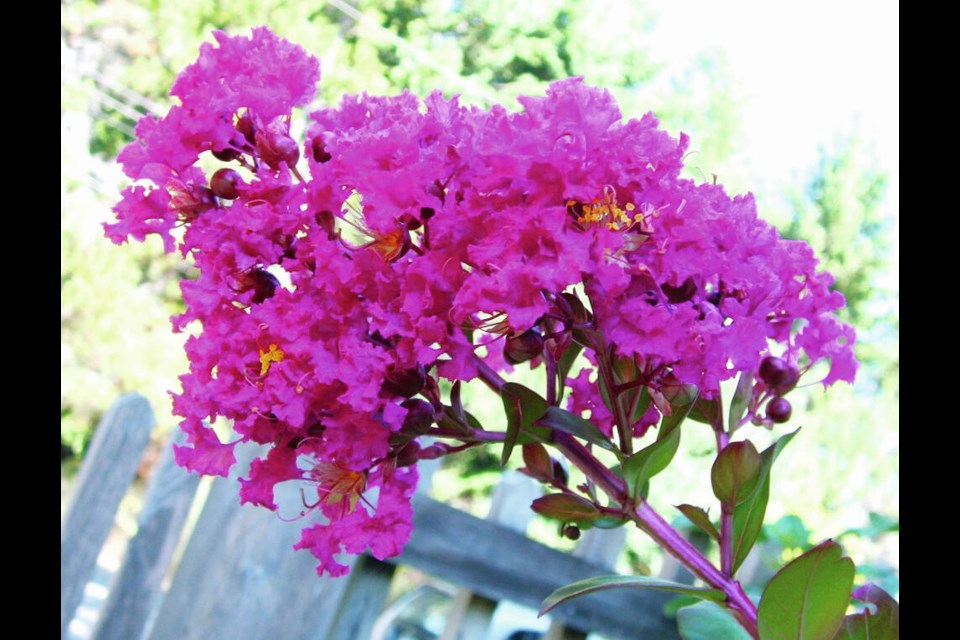Dear Helen: Some time ago you wrote about the many virtues of crape myrtles. This sounds like an ideal plant for a site we have in full sun with well drained soil. How tall is your plant? We hear they are small and delicate. Please advise.
C.E.
The crape myrtle shrubs I have are fairly compact. With pruning, I keep them to around 120 cm tall and wide. I grew them years ago from seeds I purchased as a house plant crape myrtle blend. I had set the plants outdoors for the summer, planted into garden plots, and forgot to repot and bring them back indoors in late summer. To my surprise, they survived the winter and proceeded to endure and flourish in the outdoor garden..
Crape myrtle (Lagerstroemia indica), depending on the variety, can grow anywhere from one to 7.5 metres high. Most grow as wide, or almost as wide, as they are tall. To see a gallery of crape myrtle shrubs and small trees, visit monrovia.com. Monrovia is a major supplier of plants to our local nurseries. In the upper left corner you’ll see a “Search Monrovia” line. Type in “Lagerstroemia.”
The next step will be to phone a few of your favourite local garden centres to find a source for a shrub of a size and flower colour that fits your location and suits your preferences. Crape myrtles bloom in varied shades of pink, red and white. The fall foliage puts on a lovely display of colour in the fall. Mine turn coppery apricot pink. Others turn orange-red to maroon.
Dear Helen: Can you tell me why my trailing philodendron leaves develop blackened areas before they wither and die?
P.B.
The blackened leaf areas that you describe can most commonly be traced to watering issues.. It is usually over-watering, often combined with low light levels, insufficient air circulation and/or a potting soil with poor drainage. These conditions can lead to fungus issues and some rotting of roots.
Check that the pot is not too large for the plant. That often leads to an over-wet soil because potting mix that is empty of roots tends to remain wet once watered. New roots venturing into wet soil are prone to rotting.
Make sure the pot’s drainage holes are not clogged, but are free to release excess moisture in the soil.
Dear Helen: I am growing blueberries in a raised bed and find it challenging to be sure of the soil’s pH level. Are the inexpensive pH metres in stores as accurate as laboratories that do soil testing? I add sulphur to the soil to increase the acidity.
H.C.
Soil testing lab results are considered more accurate than readings on pH metres sold for home gardener use.
In our coastal, wet-winter climate, a gardener can presume that a garden’s soil will be at least slightly acidic, because soil acidification occurs naturally as winter rains leach out alkaline elements, mainly calcium and magnesium. The acidification is more rapid and pronounced in light, sandy soils, which drain quickly of moisture for accelerated leaching.
Monitoring the condition of the blueberry plants is another way to judge whether the soil is delivering the needed degree of soil acidity which, ideally, will be between 4.5 and 5.5.
Insufficient acidity in the soil will make itself known in specific symptoms. The leaves will be smaller than normal. They will also become yellow, with green veins. New growth will be stunted. If your blueberry bushes show normal growth and productivity, presume the soil suits them.
Sulphur scratched into the soil is a safe way to increase acidity as long as the sulphur is applied lightly and no more than twice a year, in spring and/or fall. Acidifying mulches such as bark mulch also help to lower a soil’s pH.
I’ve never had to take special measure to increase the acidity of my blueberry bushes, though I do occasionally scatter used, saved coffee grounds, which are acidic, over their soil. And every spring I spread the used potting mix from the previous year’s patio pots under the bushes.
GARDEN EVENT
Dahlia meeting. The Victoria Dahlia Society will meet on Thursday at 7 p.m. in St. Michael’s Church, 4733 West Saanich Rd. Phil Newton will present the best 30 dahlias for growing and cutting. Visitors are welcome.



